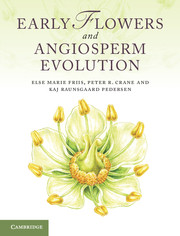Book contents
- Frontmatter
- Contents
- Preface
- 1 Introduction to angiosperms
- 2 The nature of the angiosperm fossil record
- 3 The environmental context of early angiosperm evolution
- 4 Stratigraphic framework and key areas for Cretaceous angiosperms
- 5 Angiosperms in context: extant and fossil seed plants
- 6 Origin and age of angiosperms
- 7 Phylogenetic framework and the assignment of fossils to extant groups
- 8 Fossils near the base of the angiosperm tree
- 9 Early fossil angiosperms of uncertain relationships
- 10 Early fossils of eumagnoliids
- 11 Fossils of monocots
- 12 Fossils of eudicots: early-diverging groups
- 13 Fossils of core eudicots: basal lineages
- 14 Fossils of core eudicots: rosids
- 15 Early fossils of eudicots: asterids
- 16 Patterns of structural diversification in angiosperm reproductive organs
- 17 History and evolution of pollination in angiosperms
- 18 History and evolution of dispersal in angiosperms
- 19 Vegetational context of early angiosperm diversification
- 20 The accumulation of angiosperm diversity
- References
- Index
3 - The environmental context of early angiosperm evolution
Published online by Cambridge University Press: 07 September 2011
- Frontmatter
- Contents
- Preface
- 1 Introduction to angiosperms
- 2 The nature of the angiosperm fossil record
- 3 The environmental context of early angiosperm evolution
- 4 Stratigraphic framework and key areas for Cretaceous angiosperms
- 5 Angiosperms in context: extant and fossil seed plants
- 6 Origin and age of angiosperms
- 7 Phylogenetic framework and the assignment of fossils to extant groups
- 8 Fossils near the base of the angiosperm tree
- 9 Early fossil angiosperms of uncertain relationships
- 10 Early fossils of eumagnoliids
- 11 Fossils of monocots
- 12 Fossils of eudicots: early-diverging groups
- 13 Fossils of core eudicots: basal lineages
- 14 Fossils of core eudicots: rosids
- 15 Early fossils of eudicots: asterids
- 16 Patterns of structural diversification in angiosperm reproductive organs
- 17 History and evolution of pollination in angiosperms
- 18 History and evolution of dispersal in angiosperms
- 19 Vegetational context of early angiosperm diversification
- 20 The accumulation of angiosperm diversity
- References
- Index
Summary
The global environment during the earliest phases of angiosperm diversification was radically different from that of today. The geography and distribution of continents was unlike that of our modern world and the Cretaceous was also a time of generally higher sea levels and higher global temperatures. There were low thermal gradients from the equator to the poles (DeConto et al., 2000a; Gale, 2000; MacLeod et al., 2000), patterns of rainfall were quite different (Parrish, 1987) and there is no unequivocal evidence of polar ice caps during the Cretaceous and Early Cenozoic (Gale, 2000). The Cretaceous is often considered the classic example of ‘greenhouse’ or ‘supergreenhouse’ conditions in Earth history. These unusual conditions compared with today profoundly influenced the ecology and evolution of life on land as angiosperms underwent their initial radiation and then diversified to become the dominant primary producers in most terrestrial ecosystems. Our modern world provides a poor analogue for the environmental backdrop against which more than half of the evolutionary history of angiosperms unfolded. In this chapter we provide a brief overview of changes in palaeogeography and palaeoclimate through the Cretaceous period, a time interval of 80 million years (Figure 3.1). More detailed accounts can be found elsewhere (e.g. Skelton, 2003b). The aim here is to provide a short summary that places patterns of early angiosperm evolution in their environmental context.
Palaeogeography
During the later Palaeozoic and Triassic a single supercontinent, Pangaea, was formed through the coalescence of all pre-existing major continental masses. The southern part, Gondwana, consisted of South America, Africa, Apulia (present-day Italy), Arabia, Australia, New Zealand, Antarctica, India, and Madagascar. The northern part, Laurasia, consisted of many smaller and larger continents with North America, Greenland, Europe, Iberia, Siberia, Kazakhstan, Kolyma and China as its main components. Pangaea persisted into the early Mesozoic, but began to break up during the Triassic and Jurassic through a series of processes that continued into the Cretaceous (Figures 3.2–3.5) (Smith et al., 1981; Scotese et al., 1988).
- Type
- Chapter
- Information
- Early Flowers and Angiosperm Evolution , pp. 39 - 54Publisher: Cambridge University PressPrint publication year: 2011
- 1
- Cited by



